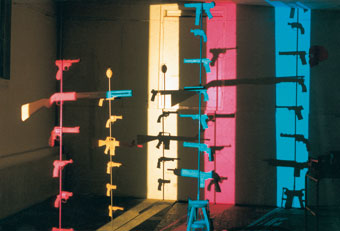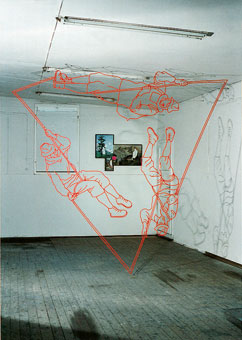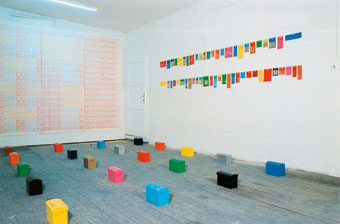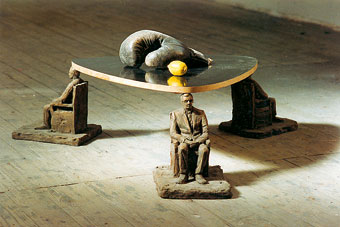
|
Shot - Reverse Shot
1992 - 1994
Room installation consisting of three steles, each bearing seven wooden models of guns, small motors, slide projectors and spotlights, and a series of photos. Steles: metal tube, each 180 cm high. Wooden guns: spruce; to scale. Photos: series of photos consisting of diptychs, 50 x 75 cm each.
The wooden models of various guns are made to scale following illustrations in an American gun magazine, mounted one above the other on the steles, with all guns on one stele pointing in the same direction. Motors rotate the pieces of “artillery” around their own vertical axis, causing them to appear everywhere on various sections of wall – illuminated by spotlights and slide projectors. The photos show the guns in “stills” of fictitious acts, each combined with “gun still lifes”.
War | Kärntner Landesgalerie, Klagenfurt | March 21 – May 5, 1996 | exhibition participation | catalog.
Collection of the Kärntner Landesgalerie, Klagenfurt.
|
Schuss - Gegenschuss
1992 - 1994
Rauminstallation, bestehend aus drei Stelen mit je sieben Holzmodellwaffen, Kleinmotoren, Diaprojektoren und Scheinwerfern sowie einer Fotoserie. Stelen: Metallrohr, je 180 cm Höhe. Holzwaffen: Fichtenholz; maßstabsgetreu. Fotos: Fotoserie bestehend aus Diptychons, je 50 x 75 cm.
Die Holzmodelle von verschiedenen Schusswaffen sind maßstabsgetreu nach Abbildungen in einer amerikanischen Waffenzeitschrift gebaut, übereinander an den Stelen angebracht und zeigen je Stele in dieselbe Richtung. Motoren drehen die drei „Geschütze“ um die eigene Vertikalachse und lassen sie, von Scheinwerfern und Diaprojektoren beleuchtet, allgegenwärtig an verschiedenen Wandabschnitten auftauchen. Die Fotos zeigen die Waffen in „Stills“ fiktiver Handlungen jeweils gepaart mit „Waffen-Stillleben“.
Krieg | Kärntner Landesgalerie, Klagenfurt | 21. März bis 5. Mai 1996 | Ausstellungsbeteiligung | Katalog.
Sammlung Kärntner Landesgalerie, Klagenfurt.
|

|
Roped Party or We Do Not Communicate with Ourselves
1992/1993
Room installation consisting of an iron-wire object and a picture object consisting of three reworked pictures. Iron object: approx. 5 mm thick iron wire painted orange; 300 x 300 x 300 cm. Picture object: oil and acrylic on hardboard, approx. 106 x 82 cm.
The iron frame depicts three mountaineers abseiling, all hanging on one and the same rope that forms a closed triangle. The mountaineers motifs are by Adalbert Pilch and were taken from an illustration in a children’s encyclopedia describing various techniques of abseiling. The picture object consists of three found mountainscapes and landscapes that W.W. Anger reworked with the three mountaineers motifs. The loop created by the closed form of the object, the rope, illustrates a quotation from Slavoj ŠZiŠzek concerning the impossibility of communication.
Acquisitions of the Ministry of Science and Art | Studio of Neue Galerie am Landesmuseum Joanneum, Graz | October to November 1995 | exhibition participation.
Collection of the Neue Galerie am Landesmuseum Joanneum, Graz.
|
Seilschaft oder wir kommunizieren nicht mit uns selbst
1992/1993
Rauminstallation, bestehend aus einem Eisendraht- und einem Bildobjekt aus drei überarbeiteten Bildern. Eisenobjekt: orange lackierter, ca. 5 mm starker Eisendraht; 300 x 300 x 300 cm. Bildobjekt: Öl und Acryl auf Hartfaserplatte, ca. 106 x 82 cm.
Das Eisengerüst stellt drei sich abseilende Bergsteiger dar, die an ein und demselben sich zu einem Dreieck schließenden Seil hängen. Die Bergsteigermotive stammen von Adalbert Pilch und wurden der Schautafel eines Kinderlexikons entnommen, die unterschiedliche Abseiltechniken zeigt. Das Bildobjekt besteht aus drei gefundenen und von W. W. Anger mit den drei Motiven der Bergsteiger überarbeiteten Berg- und Landschaftsbildern. Der durch die geschlossene Form des Objekts, des Seils, entstehende Loop veranschaulicht ein Zitat von Slavoj ŠZiŠzek zur Unmöglichkeit der Kommunikation.
Ankäufe des Ministeriums für Wissenschaft und Kunst | Studio der Neuen Galerie am Landesmuseum Joanneum, Graz | Oktober bis November 1995 | Ausstellungsbeteiligung.
Sammlung Neue Galerie am Landesmuseum Joanneum, Graz.
|

|
The Thing?
1992
Room and wall installation consisting of twenty-five printed cardboard caskets with handwritten captions, fifty-four handlabelled empty pieces of packaging material and linoprints. Caskets: 25 pieces, 20 x 12 x 16 cm each; cardboard; coloured paper, linoprint, Indian ink. Packaging material: 54 pieces, approx. 18 x 10 x 5 cm on average; plastic, cardboard, coloured paper, Indian ink. Linoprints: four-part “Zoom” series and two-part “Day and Night” series; Japanese watercolour on paper, 260 x 100 cm each.Total size: variable.
The packaging sleeves are affixed to the wall in two rows of twenty-five and twenty-nine. The empty shape of the plastic reveals or suggests what they once contained; each bears a quotation from Martin Heidegger’s The Origin of the Work of Art. On the floor there is a square (five rows of five) of cardboard caskets, each with Heidegger quotations and the “sketch” of one packaging sleeve on them. The linoprint rolls cover a large area of another wall and feature various arrangements of these “sketches”. Things and commodities intertwine, so that the actual object we want to experience becomes “blurred”, and the thing seems to disappear in the shell of the commodity.
International Biennial of Small Sculpture | Murska Sobota, Slovenia | 1993 | exhibition participation | catalog.
Collection of the Neue Galerie am Landesmuseum Joanneum, Graz.
|
Das Ding?
1992
Raum- und Wandinstallation, bestehend aus 25 beschriebenen und bedruckten Kartonschatullen, 54 von Hand beschrifteten leeren Verpackungen und Linoldrucken. Schatullen: 25 Stück, je 20 x 12 x 16 cm; Karton, Buntpapier, Linoldruck, Tusche. Verpackungen: 54 Stück, im Schnitt ca. 18 x 10 x 5 cm; Kunststoff, Karton, Buntpapier, Tusche. Linoldrucke: vierteilige Serie „Zoom“ und zweiteilige Serie „Tag und Nacht“; Japonaqua auf Papier, je 260 x 100 cm. Gesamtmaß: variabel.
Die Verpackungshülsen sind zweireihig à 25 bzw. 29 Stück an der Wand angebracht. Sie lassen ihren ehemaligen Inhalt durch die Leerform des Kunststoffs erkennen oder erahnen und tragen jeweils ein Zitat aus Martin Heideggers "Der Ursprung des Kunstwerks". Auf dem Boden sind die mit Heidegger-Zitaten beschrifteten und mit der „Skizze“ je einer Verpackungshülse versehenen Kartonschatullen quadratisch (5 Reihen zu je 5 Stück) aufgestellt. Die Linoldruckbahnen breiten sich großflächig über eine weitere Wand und bieten verschiedene Anordnungen dieser „Skizzen“. Dinge verschachteln sich mit Waren, sodass der eigentlich zu erfahrende Gegenstand „unscharf“ wird und das Ding in der Warenhülle zu verschwinden scheint.
Internationale Biennale für Kleinplastik | Murska Sobota, Slowenien | 1993 | Ausstellungsbeteiligung | Katalog.
Sammlung Neue Galerie am Landesmuseum Joanneum, Graz.
|

|
Otto Mühl, boxing glove and lemon
1992
Ground installation consisting of three sculptures, a kidney-shaped tabletop, a boxing glove, and a lemon. Sculptures: bronzed plaster.Lemon: plaster, painted yellow. Total size: approx. 65 x 65 x 40 cm.
The three sculptures depict Otto Mühl sitting in a chair and – describing a kind of triangle – are arranged with their backs to each other. The Mühl sculptures act as Atlantes and as table-legs, with the tabletop resting on their heads. A boxing glove and plaster lemon lie on the kidney-shaped tabletop.
Inspired by the still life Sandbag, boxing glove and lemon, 1986, by Otto Mühl, whose trial was under way at the time, W. W. Anger added the figure of Otto Mühl.
|
Otto Mühl, Boxhandschuh und Zitrone
1992
Bodeninstallation, bestehend aus drei Plastiken, einer nierenförmigen Tischplatte, einem Boxhandschuh und einer Zitrone. Plastiken: Gips bronziert. Zitrone: Gips, gelb bemalt. Gesamtmaß: ca. 65 x 65 x 40 cm.
Die drei Plastiken stellen Otto Mühl in einem Sessel sitzend dar und sind – eine Art Dreieck beschreibend – einander den Rücken zukehrend aufgestellt. Die Mühl-Plastiken fungieren wie Atlanten, auf deren Kopf die Platte aufliegt, als Tischbeine. Auf der Nierentischplatte liegen ein Boxhandschuh und die Gipszitrone.
Die Arbeit bezieht sich anlässlich des damals aktuellen Gerichtsprozesses um Otto Mühl auf dessen Stillleben Sandsack, Boxhandschuh und Zitrone, 1986, und ist von W. W. Anger durch die Person Otto Mühls erweitert.
|



